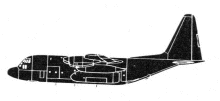Incident Overview

Description
The Lockheed WC-130H Hercules was destroyed when it impacted Augusta Road (Highway 21) and burst into flames shortly after takeoff from Savannah/Hilton Head International Airport, Georgia, USA. All nine occupants suffered fatal injuries. The aircraft was attached to the Puerto Rico Air National Guard and had been undergoing routine maintenance in Savannah before heading to the Aerospace Maintenance and Regeneration Group (AMARG) at Davis Monthan Air Force Base in Arizona. The MA had been at Savannah for almost a month, since 9 April 2018, to undergo prescheduled fuel cell maintenance and unscheduled work on engine number one by 156 AW maintenance personnel using the facilities of the 165th Airlift Wing. During takeoff roll, engine no.1 RPM fluctuated and did not provide normal RPM when the captain advanced the throttle lever into the flight range for takeoff. Approximately eight seconds prior to aircraft rotation, engine no.1 RPM and torque significantly decayed, which substantially lowered thrust. The fluctuation on roll and significant performance decay went unrecognized by the crew until rotation, when the captain commented on aircraft control challenges and the aircraft veered left and nearly departed the runway into the grass before it achieved flight. As the crew retracted the landing gear, they identified the engine no.1 RPM and torque malfunction and the captain called for engine shutdown. However, the crew failed to complete the Takeoff Continued After Engine Failure procedure, the Engine Shutdown procedure, and the After Takeoff checklist as directed by the Flight Manual, and the aircraft’s flaps remained at 50 percent. Additionally, the captain banked left into the inoperative engine, continued to climb, and varied left and right rudder inputs. At an altitude of approximately 900 feet mean sea level and 131 knots indicated air speed, the captain input over nine degrees of left rudder, the aircraft skidded left, the left wing stalled, and the aircraft departed controlled flight and impacted the terrain on Georgia State Highway 21. USAF AIB CONCLUSION: “After a comprehensive investigation into this mishap, I find, by a preponderance of the evidence, the cause of the mishap was MP1s improper application of left rudder, which resulted in a subsequent skid below three-engine minimum controllable airspeed, a left-wing stall, and the MAs departure from controlled flight. Additionally, I find, by a preponderance of the evidence, the MCs failure to adequately prepare for emergency actions, the MCs failure to reject the takeoff, the MCs failure to properly execute appropriate after takeoff and engine shutdown checklists and procedures, and the Mishap Maintainers failure to properly diagnose and repair engine number one substantially contributed to the mishap.”
Source of Information
http://www.wbtv.com/story/38094821/witnesses-report-seeing-plane-go-down-near-gulfstream-rd-hwy-21-in-port-wentworthhttp://www.wbtv.com/story/38094821/witnesses-report-seeing-plane-go-down-near-gulfstream-rd-hwy-21-in-port-wentworthPrimary Cause
MP1’s improper application of left rudder, resulting in a subsequent skid below three-engine minimum controllable airspeed, a left-wing stall, and the MA’s departure from controlled flight.MP1’s improper application of left rudder, resulting in a subsequent skid below three-engine minimum controllable airspeed, a left-wing stall, and the MA’s departure from controlled flight.Share on:





